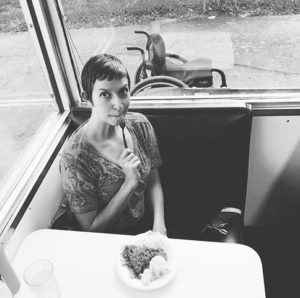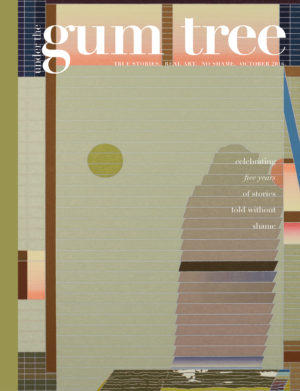Rebekah Taussig

Rebekah Taussig is finishing her PhD from the University of Kansas and lives in a little, old house with two chunky cats in Kansas City. Her work often questions what it means to live in a particular body, and you can always find her pressing into this inquiry on her Instagram account @sitting_pretty. She is thrilled that her first published piece “Reupholstered” has found a home in Under the Gum Tree.
When and why did you start writing? What inspires your writing most now?
I wrote my first book when I was about five or six years old. I snatched a giant stack of computer paper, folded off the perforated edges, folded the pages in half, and told a story with pictures and a few words about a dark blue car driving through torrents of rain. As I got older, I wrote cheesy poems about sunsets and spider-webs, filled my journal pages with rants and confessions, and wrote essays for class about the absurdity of calories and cliques. I filled my undergraduate degree with strange and quirky short fiction and spent a good chunk of my life writing academic papers about Victorian literature during my master’s degree. But from the blue car driving through the rain to the analysis of disability representations in nineteenth century novels, I think I’ve always been drawn to writing because life confuses me. My inside world and my outside world often clash. I can feel confused, far away, disconnected, alone, bewildered. Writing feels like the bridge—the tool that allows me to make connections, build something I can grip onto—even if it’s just choosing the precise words to crystalize the moment I felt the universe would find a way to hold itself together when I glimpsed the light shimmy through a spider-web.
Why are you drawn to nonfiction?
I had been writing academic papers about disability and literature for years when I stumbled into my first creative nonfiction workshop. This was the first time I wrote directly about my own paralyzed body. I remember crafting the scene about the afternoon I overheard a friend say he didn’t want me to come sledding because he didn’t want to have to lug “that cripple” up the hill. It was a sharp, painful memory, but as I built it on the page—weaving and whittling it into a shape that felt honest—I felt awake and full. Creative nonfiction can be cathartic for both the reader and the writer, but it is also playful. It invites and empowers. It allows me to write about the things that catch me in the throat, without having to invent a cloak or a pretense.
Also, as a person with a disability, I believe that narrating my own, personal experience is a revolutionary act, and one I hope more and more people will do. Historically, people with disabilities have been written over and spoken for. Representing myself, as myself, participates in changing a larger cultural script that traditionally confines folks with disabilities.
What events do you think warrant a story or should be written about?
If Joy Castro and Eula Biss have taught me anything about creative nonfiction, every event, macro or micro, can evolve into a compelling story. In my own work, I am drawn to write about the events that won’t stop nettling me—that keep coming back to me during the day and when I’m trying to fall asleep at night, that make me feel things I can’t quite explain. This is exactly what happened with “Reupholstered.” After Lydia prayed for me in the coffee shop, I felt like I couldn’t breathe, and I didn’t understand why. For weeks, I kept bringing the incident up in conversation. It wouldn’t leave my mind—I could feel it clinging to the inside of my body. I started writing, and I still didn’t fully understand, but that unrelenting curiosity is the very juice that brings me back to the fourth and fifth and sixth drafts—the drafts where connections are discovered and hard-earned revelations decide to emerge. I also think this curiosity is the thread that leads us toward universal connections—when we dig and dig and keep digging for the motivations behind the motivations, I think (I hope) we find each other, all working out our own unique versions of shame, healing, fear, empowerment, loss, and reclamation.
Lydia’s kindness in “Reupholstered” is somewhat marred by her blatant ableism. Is this a conversation/interaction you endure often?
People offering to pray over my body for its healing is something that happens relatively often. People making assumptions about me based on my physicality—that my partner is my hired care-taker, that I must wish to live in a body different than the one I have, that I don’t have a sexuality, that my life is forever tinged with a bit of tragedy, that I can’t open a door, get my wheelchair in and out of my own car, or carry my own grocery bags—happens regularly. It’s not possible to extract ableism from my daily experience. It’s a rhythm I’m sure anyone in an underrepresented, marginalized identity is familiar with—that feeling that you have to fight so hard to be really seen, not as a symbol or a short-hand or a collective face, but as me, my own self with a complicated history and a vibrant, often contradictory inner-world.
Your piece is a step in the right direction in talking honestly about people with differently abled bodies. Have you found it difficult to express this before?
Before I started writing nonfiction, I don’t think I ever spoke honestly about my particularly abled body, even to myself. Not fully. Despite the fact that I’ve been paralyzed since the age of three, I too was raised in a culture saturated in ableist thinking. My body felt like something to overcome, ignore, rise above—essentially, an object from which to detach. I started reading a lot of writers who engage this conversation with a wealth of intellectual curiosity—Alison Kafer, Andrew Solomon, Eli Clare—and I started to see myself as part of a larger community with a long history and shared stories. I moved hesitantly toward sharing my own stories through an Instagram account called sitting_pretty. (I spent much too long and way too many paper napkins coming up with that clever little name—good grief!). I used (and still use) this virtual space to share brief glimpses into my experiences as a woman with a disability. Very quickly, I felt overwhelmed by the many voices of understanding and support that met me there. I felt connected and seen in a way I’d never experienced before, which has led me to more writing, more sharing, more connecting. I am sure that part of the reason it took me so long to step into the process of narrating my experiences with disability is because I hadn’t seen it modeled. As a culture, we need more stories that represent the idiosyncratic, personal, contradictory experiences of living life with a disability, because stories have the power to shape the way we see each other—they provide a script for how we interact with one another. We need more stories that flip the script surrounding bodies with disabilities.
The reupholstered couch was perfect as it was before it was “fixed.” Why do you think people desire to fix what they perceive as damaged? Do you think this reflects more about them than anything else?
I think that part of this impulse to categorize things as marred versus flawless, defected versus perfect, used versus fresh, broken versus whole comes from an illusion that we can wipe the slate clean, sanitize the instruments, fight off deterioration and decay and maintain a sense of control. I think we lose something when we do this. In an attempt to fight off what we’ve come to perceive as “damaged,” we erase and ignore the very stuff of life—stretch marks, scars, thread-bare pillow cushions, paralyzed legs—all evidence of vibrant, excessive, full-bodied, screaming-from-the-rooftops life. At least, this is how I’ve come to see it.




